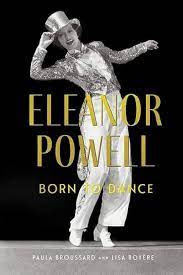Tripping My Way Through “Eleanor Powell: Born to Dance”

“Nice” doesn’t make youfamous. It doesn’t sell copies of magazines or get you invited to appear on TVtalk shows. Ron Howard, for one, has spent much of his adult career dodging the accusation that he’smerely a nice guy. But Paula Broussard and Lisa Royère have devoted their firstbiography to a woman who balanced star power with a personal graciousness thatmade her a joy to be around. They should know. When That’s Entertainment introducedthem to Eleanor Powell (who starred in glossy MGM musicals from 1936 to 1943),the two fell in love with her spectacularly athletic tap-dancing. Dance-madthemselves, they managed to befriend the long-retired Powell, and were charmedby her friendly and upbeat manner. And yet their dream of compiling a pictorialguide to Powell’s films was put on hold for decades. It was the pandemic thatrevived the project, which then evolved into a fully-researched new biography, EleanorPowell: Born to Dance.
Powell’s early life, welearn, was not an easy one. Raised in tight circumstances by a single mother,she discovered in dance a way to overcome her shyness. At an early age she made it to the Broadwaystage as a variety performer. Though shefirst specialized in ballet and acrobatics, she eventually learned to tap, andthis became her springboard to Hollywood. Before reading Born to Dance Ihad never considered the importance of tap-dancing in early Hollywood musicals.In the decade after sound entered the picture, audiences thrilled to therhythmic clatter of tap shoes on a soundstage floor. In a series of BroadwayMelody films, as well as such starring vehicles as Rosalie, Honolulu, andBorn to Dance, Powell thrilled audiences with bravura production numbers(like dancing down a series of oversized drums) while also performing romantic duetswith the likes of James Stewart and Robert Taylor.
Of course audiences clamoredfor her to be paired with the greatest of male ballroom dancers, Fred Astaire.According to Broussard and Royère, the self-critical Astaire resisted for quitea while the opportunity to be her dance partner. Finally it happened. In BroadwayMelody of 1940, a sentimental tale of two hoofers and the woman who comesbetween them, they wowed audiences with Cole Porter’s “Begin the Beguine,” in what has been called the greatesttap sequence in the history of Hollywood. Performed on an elaborate mirroredset, it begins with a mood of Latin elegance, then shifts midway through intojoyous jazz. Alas, though audiences hoped for an encore,it was not to be. Amazingly, Astaire was intimidated by her powerful tapskills, saying that “I had twenty-nine partners, but I met my match withEllie.”
The end of her partnershipwith Astaire was not the only disappointment in Eleanor’s life. Tastes inentertainment changed, and she faced some health challenges. Her one stab atmatrimony ended in disaster: husband Glenn Ford turned out to be a compulsivewomanizer, and one who also stepped out with men. When they finally divorced,he proved himself a cad about finances, and she was too ladylike to object.Needing to raise son Peter on her own, she courageously resurrected her careeras a nightclub entertainer after years of devoting herself solely to thedomestic realm. Through it all, a strongreligious faith kept her sane.
One truly admirable thingabout Eleanor: she refused to accept skin color as a barrier to friendship. Sheand the great Bill “Bojangles” Robinson shared routines; Robinson and PearlBailey were honorary godparents to her son. A lovely lady, in every sense ofthe word. Brava!
Beverly in Movieland
- Beverly Gray's profile
- 10 followers



